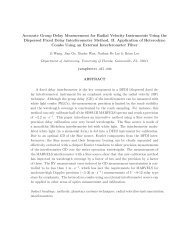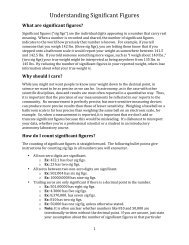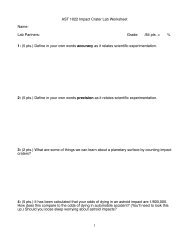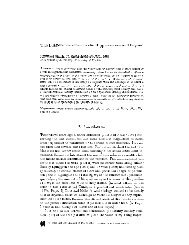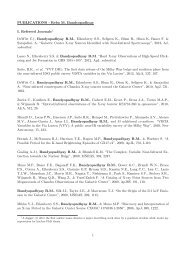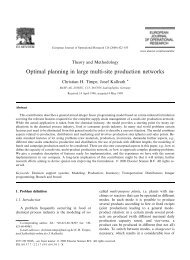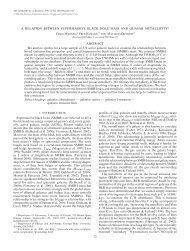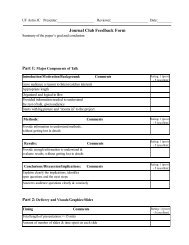The Secant method for simultaneous nonlinear equations
The Secant method for simultaneous nonlinear equations
The Secant method for simultaneous nonlinear equations
Create successful ePaper yourself
Turn your PDF publications into a flip-book with our unique Google optimized e-Paper software.
<strong>The</strong> <strong>Secant</strong> Method <strong>for</strong> SimultaneousEquationsNonlinearl'mL[V WOI, FE, <strong>The</strong> RAND Corporation, Santa Mo~ffca, Cali<strong>for</strong>niaAbstract. A procedure <strong>for</strong> the <strong>simultaneous</strong> sohition of a sys{)emof not-necessarily-linear <strong>equations</strong>, t~ generalization of the secanl,<strong>method</strong> <strong>for</strong> a single function of one w~ri~fi)le, is given.1. <strong>Secant</strong> Method <strong>for</strong> n EquationsThis note is concerned with a eomputationM procedure<strong>for</strong> the solution of the <strong>simultaneous</strong> <strong>equations</strong>(1) f~(x) = 0, i = 1, .-. ,n,where x = (x~ , ... , x,) ~ I/:,, and each fi is a computablefunction of x. (For the later theoretical discussion of theprocedure, the f~ will be supposed to have second derivatives,but no derivatives are calculated.)<strong>The</strong> procedure consists in the iteration of the followingstep, at the beginning of which it is assumed thai; then + 1 "trial solutions" x ~, ... , x '~ ~1 are at hand.Find rrt, ... , rr~,+l such that(2)and(3)let(4)i~+ltr~+t~r:= 1j=lrr:fi(x j) = 0 <strong>for</strong>i = 1, -'' ,rt;n + 1-~ E ~r J x j,j~l~and obtain a new set of trial solutions by replacing, with2, some x i <strong>for</strong> which ]! S I! is maximal, where(,5) /I :~, II -- E If.i(:r) I ~.Note that <strong>for</strong> the case n = 1 the abow; is just the ordinarysecant <strong>method</strong> <strong>for</strong> finding the root of a single functionf by finding that point on the line through two trim points(x t, f(x ~) ), (x 2, .f(x ~) ) on the graph of f which lies on thex-axis. Note also that in case the f~ are all linear, 2 is immediatelythe solution. Finally, note that the choice ofnorm I] x !I in (5) was pretty arbitrary; it is not knownwhether other norms would be more effective.2. Convergence of the MethodIn the <strong>for</strong>mulas below, let z t)e the solution of the system(1); let Gi be the vector of first partial deriv~ttives ~ of flwith respect to x~, • •. , x~, ; let 2Q~ be the matrix of secondpartial derivatives ~ of f~ ; arid let ~ denote equality to~Atx = z.within terms of second order of the quantities (S -- z).Using (2) liberally,L(2) ~ c,~(, " ~ - z) + (:e - z)Q/~ - z)= ~2, wG
which is to replace the jth eohunn of A, where x 5 is thetrial solution dropped in this iteration. <strong>The</strong> new inverse is~'al< ulated from the old by pivoting:~mdCalculate q = A,-~p. <strong>The</strong>n:t. Computational(A*-'),a: -= (A--~) ~:/qj(A.-*),~. = (A-*),~ - (.4.),.~.. -* (q,/qk)Experience<strong>for</strong> all/%<strong>for</strong> %j,all k.A FOgTRAN II program has been written <strong>for</strong> trying outthis procedure. Its input consists of n, a set of trial solutionsor a signal that such a set should be generated, andprograms which eMeulate the f,. A variety of problemswith n = 2 have been solved. <strong>The</strong> process has converged<strong>for</strong> these in a manner like that which Jeeves [1] has shown<strong>for</strong> the ease rt = 1, namely that the error at a given step isproportional to the product of the errors at the two previotissteps--convergence of order ½(,v/5 + 1).SAMPLE:_ n = -,'2 fl(x, y) = :r9 + :t: -- y2 @ 1,.f2(x, y) = y(1 -- 2x) (the real and imaginary parts ofz2+z+ 1).InitiMPointsNormxy(1 --0.600000 1.100000 0.370000t2 --0.300(N0 1.10(NO0 1.518400--0.600000 1.400000 0.2509004 --0.516058 0.923358 0.0113515 --0.503347 0.870741 0.0001016 --0.500884 0.866819 0.423 X 10 -~7 --0.499988 0.865996 0.306 X 10 -s8 --0.500000 0.866025 0.105 X 10




